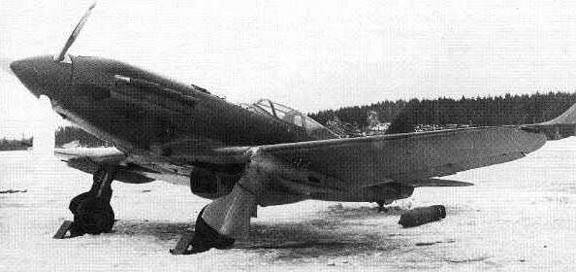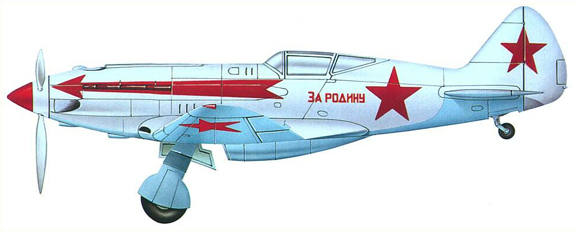WARBIRD RESOURCE GROUP > RUSSIAN AVIATION > FIGHTERS > PREVIOUS PAGE

|
Type: Single-Seat Fighter Origin: Mikoyan First Flight: May 1941 Service Delivery: N/A Final Delivery: Late 1941 Number Produced: Around 3,322 Engine: Type: Mikulin AM-35A V-12 Liquid Cooled Number: One Horsepower: 1,350 hp Dimensions: Wing span: 33 ft. 9.5 in. (10.3m) Length: 26 ft. 9 in. (8.15m) Height: 8 ft. 7 in. (2.61m) Wing Surface Area: 187.73 sq. ft. (17.44 m²) Weights: Empty: 5,721 lbs. (2595 kg) Max. Take-Off: 7,385 lbs. (3350 kg) |
Performance: Maximum Speed: 398 mph (640 km/h) Initial climb: 3,937 ft./min. (1200 m/min) Service Ceiling: 39,370 ft. (12,000m) Range: 776 Miles (1250 km) Armament: One 12.7mm BS machine gun in nose Two 7.62mm ShKAS machine gun in nose Later supplememnted with field kits, allowing two additional unsynchronised 12.7mm BS machine guns to be mounted in underwing pod Bomb Load: Underwing rails for six RS-82 rockets Or Two 220 lb. (100 kg) bombs or two chemical containers |
By the time of Operation Barbarossa, over 1,200 MiG-3's had been delivered.

However that was not the end of the issues that the MiG-3 encountered during its deployment. Several MiG-3s produced were found to have unacceptable performance at altitude due to oil and fuel pressure. It was also found that pilots attempted to fly the MiG-3 as if it were an earlier aircraft (especially the forgiving Polikarpov I-15, I-153 and I-16's) and which led to several other problems. Soon new oil and fuel pumps were introduced as well as attempts at better pilot training to familiarize them with the MiG-3.
Over the next two years the MiG-3 several new changes made it into production, including up-gunning to UBS machine guns and ShVAK cannons.

Even with the MiG-3's limitations, Alexander 'Sasha' Pokryshkin, the second leading Soviet ace of the war with 59 official victories, recorded most of those victories while flying a MiG-3.
WARBIRD RESOURCE GROUP > RUSSIAN AVIATION > FIGHTERS > PREVIOUS PAGE
